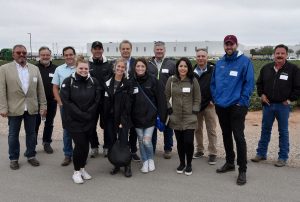How BASF Helps Clothing Brands Understand Cotton
Clothing brand representatives learned more about how cotton is grown during a recent BASF Cotton Production Field Day in Lubbock, Texas. Part of the program included information about e3™ cotton, an effort to produce economically sustainable cotton that’s good for the environment.
“The idea of the product is that it’s a sustainable cotton and it’s a continual improvement commitment by the farmers that decide to grow it,” said Andrew Olah, CEO of Olah, Inc. “And for the brands that want to get involved with it, they can associate with the farmers in the process that is actually good for the environment.”
Representatives from major clothing brands including Ralph Lauren, Target, Wrangler Jeans and JCPenney had questions for farmers and BASF representatives about the process of cotton production.
“A big problem in the clothing business and in consumer apparel, in general, these days, is disinformation,” said Bob Antoshak, Managing Director at Olah, Inc. “The amount of smoke and spin that’s out there in the trade and in the consumer world is so extensive that events like this help us to show factually what the cotton is all about, how its grown, but more importantly, who is doing the growing. It’s a chance for these buyers to actually meet farmers, and that’s a really critical element of this program.”
 The program is just as important to cotton producers, said Malin Westfall, U.S. Cotton Lead for BASF.
The program is just as important to cotton producers, said Malin Westfall, U.S. Cotton Lead for BASF.
“We’re hosting a group of clothing brands, which are far removed from the farmer, because they want to gain a better understanding of what farmers do. How they are raising cotton, what kind of management practices they use, because it’s important to them and their consumers,” said Westfall.
Westfall said defining sustainability is becoming more and more important throughout the production chain. And while that’s a conversation that typically focuses on food, it’s just as important when it comes to fiber.
Listen to Chuck’s interview with Andrew and Robert here: Interview with Robert Antoshak and Andrew Olah of Olah, Inc.
Listen to Chuck’s interview with Malin here: Interview with Malin Westfall, US Cotton Lead
KEENAN, InTouch Systems Provide Daily Information
 Dairy producers visiting the 2018 World Dairy Expo had the opportunity to learn more about KEENAN mixers and the InTouch system from Dan Gard, KEENAN sales manager for the United States.
Dairy producers visiting the 2018 World Dairy Expo had the opportunity to learn more about KEENAN mixers and the InTouch system from Dan Gard, KEENAN sales manager for the United States.
“KEENAN has no dead spots in the mixer, so it delivers a consistent, uniform mix for the ration regardless of the ingredients, and that’s really what sets it apart,” said Gard. “InTouch is the communications platform that’s in the controller on the mixer, and it’s a real-time performance monitoring system where it monitors the performance of the mixer on a daily basis, the mixer operator, and also the performance of the livestock that the producer is trying to raise and market from the farm.”
Gard said InTouch works through existing cell phone service and automatically uploads information on a daily basis.
That information is collected and summarized into reports for the producer and trusted advisors to review and make management decisions based on the performance of the operator or the animals on the farm. Consultants can also send rations straight to the mixer.
More information is available from local Alltech representatives and Hubbard Feeds dealers throughout the United States, as well as on the KEENAN website.
Listen to Jamie’s interview with Dan here: Interview with Dan Gard, KEENAN
Precision Ag Bytes 10/4
- TerrAvion, the largest volume provider of aerial imaging real-time data for agriculture, and FieldX®, the leading provider of software for independent agronomists, announced the launch of an integration that brings aerial imagery solutions to agronomists using FieldX.
- Verdesian Life Sciences has expanded its research pipeline by opening a greenhouse facility at Duke University to develop early technology validation screening for agricultural nutrient use efficiency technologies.
- The American Seed Trade Association applauds the news of a new trade agreement between the U.S. and its two largest export markets: Mexico and Canada. While ASTA is still reviewing the full details of the agreement, the association is pleased to see the language includes its core priorities for trade. Most notably, the agreement provides stronger support for agricultural biotechnology and the trait approval process; recognizes the importance of evolving plant breeding methods like gene editing; strengthens science-based sanitary and phytosanitary regulations; and provides strong intellectual property protections, including adoption of UPOV 91 requirements.

Trade Agreement Encourages Edge Dairy Cooperative
The new trade agreement between the United States, Canada and Mexico (USMCA) has generated a lot of discussion at the World Dairy Expo in Madison, Wisconsin this week since it holds lots of promise for the industry to increased exports.
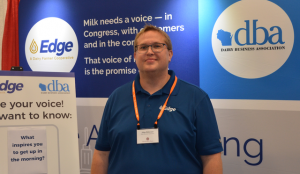 John Holevoet, director of government affairs for Edge Dairy Cooperative and the Dairy Business Association, says the main change is the abandonment of Canada’s Class 7 pricing system, which had particularly affected U.S. producers who were shipping ultrafiltered milk products into the Canadian market. While the deal has not yet been signed by all three nations, it appears it will provide long-term gain regarding overall global demand for U.S. dairy products.
John Holevoet, director of government affairs for Edge Dairy Cooperative and the Dairy Business Association, says the main change is the abandonment of Canada’s Class 7 pricing system, which had particularly affected U.S. producers who were shipping ultrafiltered milk products into the Canadian market. While the deal has not yet been signed by all three nations, it appears it will provide long-term gain regarding overall global demand for U.S. dairy products.
“We’re overall very pleased to see that it actually got done. There were moments of doubt. So, relief is one sentiment, and optimism is another,” said Holevoet.
While the timing of the agreement is still unclear, Holevoet also expects the policy to support futures market levels after a long cycle of low prices for dairy farmers.
Learn more in this interview – Interview with John Holevoet, Edge Dairy Cooperative
Balanced Dairy Rations Improve Herd Nutrition
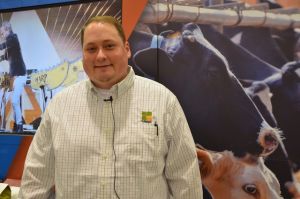 Each dairy farmer has different nutrition goals, based in part on what forages are available on farm. Hubbard dairy nutritionists like John Pretz help farmers with regular nutrient analysis so they can optimize the forages that are available and identify supplements that might further improve herd production, reproduction, and overall animal health.
Each dairy farmer has different nutrition goals, based in part on what forages are available on farm. Hubbard dairy nutritionists like John Pretz help farmers with regular nutrient analysis so they can optimize the forages that are available and identify supplements that might further improve herd production, reproduction, and overall animal health.
“I think we’ve absolutely evolved over the last few years from looking at your base nutrients – just a crude protein and a starch spec – all the way down to the specific amino acid,” said Pretz. “In a lot of ways, I’d say these cows’ diets are more precise than what we’re eating as a human being, even if we’re tracking everything that’s going into our body.”
Pretz said small changes can also make a big difference, from keeping cows cleaner to trimming hooves more often. Other examples include increasing cow comfort during day to day activities from vaccinations to milking procedures. Pretz visited with producers at the 2018 World Dairy Expo in Madison, Wisconsin.
Audio – Interview with John Pretz, Hubbard
2018 World Dairy Expo Photo Album
2018 World Dairy Expo Explores Next Frontier
 Sporting a theme this year of “The Next Frontier,” World Dairy Expo is in full swing right now in Madison, Wisconsin.
Sporting a theme this year of “The Next Frontier,” World Dairy Expo is in full swing right now in Madison, Wisconsin.
Communications Specialist Katie Schmitt says there are almost 900 companies exhibiting at the expo this year. “Our trade show is really a great place for farmers to find that new technology and do some research,” says Schmitt, who says the theme of the show is about what is next on the horizon for the dairy industry. “It is looking into what is in dairy’s future, whether it’s in the genetic side of our show world or in the technology of the trade show.”
On the show ring floor, some breed champions have already been crowned, including the Grand Champion Ayrshire, Ruth, exhibited by Palmrya Farm-Evan Creek of Hagerstown, Md., who won the trophy for the second year.
Listen to Jamie’s interview with Katie from WDE18: Interview with Katie Schmitt, World Dairy Expo Communications
Crappie Masters National Championship Winners
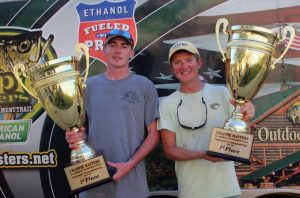 The winners of the 2018 Crappie Masters National Championship at Truman Lake in Clinton, MO last week were two 21-year-old Missouri natives, Matthew Rogers and Baylor Mead.
The winners of the 2018 Crappie Masters National Championship at Truman Lake in Clinton, MO last week were two 21-year-old Missouri natives, Matthew Rogers and Baylor Mead.
For the second consecutive year, the Renewable Fuels Association (RFA) and the National Corn Growers Association (NCGA) sponsored the national fishing tournament, which highlights the use of 10 percent ethanol (E10) in all boat motors.
The team, Matthew Rogers and Baylor Mead, won the 2018 championship with 14 fish weighing a total of 21.19 pounds using E10 in their boat, which earned them an extra $2000 on top of their $30,000.00 top prize along with an additional $2,100.00 for the 2.11 pound big fish.

2018 Male/Female team Crappie Masters National Champions Jack and Holly Linton with RFA’s Robert White
In this interview, the Lintons also talk about how they got involved with Crappie Masters – even after a disastrous first outing! Interview with Crappie Masters fishing team Jack and Holly Linton
Busting Myths About Mycotoxins
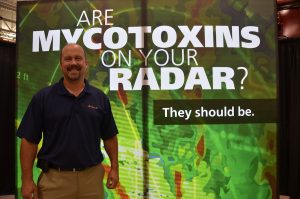 Misconceptions about mycotoxins can cause problems for cattle producers.
Misconceptions about mycotoxins can cause problems for cattle producers.
One of the biggest myths out there is that most mycotoxin challenges are caused by weather. And while weather can play a role, it’s more often field agronomic practice and insect damage that are the larger culprits when it comes to mycotoxin development, according to Pat Crowley, on-farm specialist with Alltech. Crowley says monitoring plant health is the key to keeping mycotoxin levels in an acceptable range.
“Evaluate plant health. It all starts with plant health. We want a healthy plant just like we want a healthy cow or a healthy child. If we have a healthy plant, it’s more resistant to challenges out in the field,” he said.
Crowley said this year’s unique weather patterns will likely make the crop more vulnerable to mycotoxin challenges.
“This weather pattern – I haven’t really seen anything like it. It’s extremely unique and this is going to be possibly catastrophic to what we’re going to see for crops and crop damage with the rainfall and the stage of maturity that it’s in,” he said.
Crowley encouraged farmers to scout fields for possible spots or molds and use resources like mycotoxin testing available at KnowMycotoxins.com/FreeTest. He said any Alltech representative can also provide more information about mycotoxin testing and they are at the World Dairy Expo this week to meet with producers in person.
Listen to Jamie’s interview with Pat here: Interview with Pat Crowley, Alltech
2018 World Dairy Expo Photo Album
BASF Arkansas Field Day
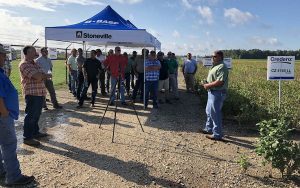 BASF held a field day last week in Marion, Arkansas to meet with groups of retailer staff and talk about the what the new BASF portfolio has to offer, particularly for soybeans (Credenz) and cotton (Stoneville). There was limited in-field opportunities for the day due to rain, but there was still a lot to share.
BASF held a field day last week in Marion, Arkansas to meet with groups of retailer staff and talk about the what the new BASF portfolio has to offer, particularly for soybeans (Credenz) and cotton (Stoneville). There was limited in-field opportunities for the day due to rain, but there was still a lot to share.
BASF Cottonseed Marketing Manager Rachel Walters says the field days give them an offer to share their story and this year they have even more to discuss with the acquisition of Bayer assets such as Stoneville. “It’s the first time that some customers are coming in and seeing the BASF logo on the tents, the signs and even on the bags,” she said.
Listen to Chuck’s interview with Rachel here:
Interview with Rachel Walters, BASF
Lance Rochelle, regional seed lead, talked about some of the new cotton varieties for this year.
Interview with Lance Rochelle, BASF
William Johnson, BASF Agricultural Solutions, gave a presentation on Credenz soybeans at the field day. Listen to that here and watch it below:
Presentation by William Johnson on soybeans, BASF


